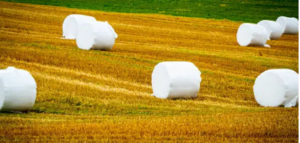Silage film is used to wrap hay and silage bales. It is to limit the availability of oxygen, preventing spoilage and preserving nutrition for livestock.
Bales should be wrapped as soon as possible after baling to prevent the onset of fermentation gases, which can cause them to burst. To reduce handling and storage losses, it is also important to keep the bales in a cool place.
 Strength and Durability
Strength and Durability
Forage crop bales are typically wrapped with silage film rolls to create an oxygen barrier and promote the fermentation of forage crops such as hay, corn stalks and grass. The film needs to be strong enough to withstand pressure from fodder plants with hard stems and provide excellent puncture resistance. The film also needs to be able to cling to itself and the bale, forming a tight seal that helps reduce air leakage, which can impact the quality of the forage crop.
The cling value of a silage film should be 8 to 9 Newtons per meter, SML says. It also needs to have a high dart impact level, which means it can resist damage during ensiling and storage. It should also be treated to resist ultra-violet light degradation, which can cause spoilage. It’s important to ensure that the silage film you choose has these qualities before purchasing it.
Bales wrapped with the right silage wrap can keep forage fresh and healthy for a long time. They can help farmers save on feed costs by reducing the need for indoor storage and reducing losses of quality forage. The best way to get the most from your bales is to use a high-performance film, such as Flavor-Seal, that has a strong cling and puncture and abrasion resistance. It also has a reflective white surface, which minimizes heat buildup and is UV-treated to prevent deterioration.
UV Stabilizers
The UV stabilizers used in silage film protect the granules against degradation by the sun and significantly extend the life of the plastic. They also ensure the safety of the workers handling the film. They can be added in various forms. For example, the additives can be combined with a base polymer during manufacturing or prepared as a master batch.
Moisture Stabilizers
This specialized film can reduce the risk of forage spoilage in the field, which can lead to unstable supply and high feed costs. It keeps grass bundles from evaporating, and the controlled anaerobic fermentation promotes the production of forage nutrients, making it easier to digest for livestock. It also protects hay from pests, mould growth, and bacteria, so it’s easy to store and feed for the animals.
Silage film is used to wrap round bales of hay, forage, and maize. It keeps the forage from spoiling during harvest, transport, and storage, ensuring that it can be preserved all year round. It ensures that farmers can keep their stock fed without needing to buy expensive feed from outside sources. It also reduces the risk of forage contamination and spoilage, which can be caused by fungus deterioration and poor air circulation. It is available in a variety of thicknesses and widths to suit different baling applications.
Visibility
Using silage film rolls, farmers can be confident in their ability to keep their hay bales sealed air tight and protected from environmental damage. It also helps to minimize spoilage and ensures that the nutrients are intact in the feed that is given to animals.
The opacity of this plastic hay wrap reduces heat buildup from sunlight and slows the fermentation process. It also allows for an optimal oxygen barrier to preserve the nutritional value of silage mixes, hay, and maize.
Additionally, this product is harmless and odourless, making it safe for humans and animals. It doesn’t contain any chemicals or pesticides that could contaminate crops or harm animals, and it can even be reused after being exposed to rain and sun. This product is a great choice for farmers who want to reduce their use of pesticides and other harmful chemicals in their farms.